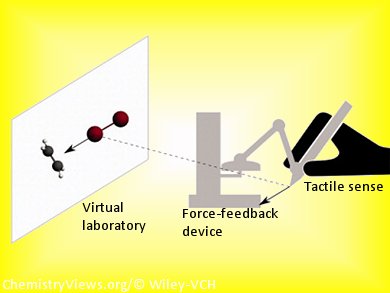Learning by Touch
The human being learns best by haptic sensing. This means by touching something and feeling its size, contour, surface texture, weight, etc. Small children start to explore their surrounding like this. Experiencing chemical reactions in this way would bring enormous advantages.
What would it be like if you could feel what happens to a molecule when it slowly moves closer to another one? Imagine you scribble a chemical reaction on a piece of paper to find out a new reaction pathway or to comprehend an existing one. Imagine that by doing so you do not only have to rely on your chemical knowledge and intuition, but also get exact feedback on the forces which work on each atom in a molecule just by moving your pen on the paper. Synthesis of new molecules and learning about reaction pathways would become easy, intuitive, and even more fun to learn and play around with.
This is not some kind of fancy science fiction idea for chemists, but a matter of actual research. Professor Markus Reiher, ETH Zurich, Switzerland, and his team work on what they call haptic quantum chemistry.
Haptic technology or haptics denotes the tactile feedback of a force or vibration to the user through a computer device. Haptic devices today already add the sense of touch and three-dimensional navigation to a broad range of applications, e.g., for medical training simulations, remote control of repair robots, or games.
In Markus Reiher’s approach, you hold a pen of a haptic device in your hand. With this you move one molecule towards another. The resulting attractive and repulsive forces are calculated quantum mechanically and fed back to the device. This then moves the pen in your hand accordingly. By this you can sense what a preferred path for the reaction is and get a feeling for the reaction.
Fast Calculations for Real-time Feedback
The problem still to be solved is that the forces have to be calculated fast. The device needs a new force update every 100 ms to react in real-time. At the moment it is impossible to achieve this extremely fast calculation speed. However, according to Markus Reiher and Moritz Haag this will be possible in the near future.
In a recent article published in the International Journal of Quantum Chemistry, Markus Reiher and his Ph.D. student Moritz P. Haag describe computational techniques that may enable the development of real-time quantum chemistry techniques. “We already possess standard approaches to achieve these high rates developed in the past two decades. More is to be expected in the future, especially by specialized hardware,” Reiher says.
They expect single-determinant models like Hartree–Fock theory and, most importantly, density functional theory (DFT) to be the best candidates for quantitative real-time reactivity exploration. Also the number of basis functions needs to be as small as possible. As many chemical reactions are rather local, they usually involve only a limited number of atoms. This means models of about 200 or even less atoms embedded in a suitable environment are sufficient. As high accuracy does not need to be the main goal, comparatively small basis sets can be used.
The greatest potential for achieving the considerable speed-up toward real time according to the researchers lies in the activation of specialized hardware. Already in reach are calculations on graphical processing units (GPUs) which show a promising potential. The calculations of two-electron repulsion integrals (ERI) are the bottleneck in almost all quantum chemical calculations, because of their sheer number. Completely new, specialized hardware which allows for a massive parallelization can directly accelerate the calculations and not only improve the scaling behavior.
Professor David Wales, University of Cambridge, UK, thinks that “the coupling of hapic technology to on-the-fly treatment of electronic structure provides new opportunities for scientists to guide calculations intuitively. It should be possible to use this new capability to locate relevant regions of configuration space, and follow this up with a more accurate treatment to yield reliable predictions.”
Asking Markus Reiher where he sees the future of this technique, he explains that “the exploitation of the human haptic sense to present scientific data more intuitively is only a first step. A deeper immersion by using techniques already developed in the field of virtual reality would be the ultimate goal of developments into this direction.”
- Real-time quantum chemistry,

Moritz P. Haag, Markus Reiher,
Int. J. Quantum Chem. 2013, 113, 8–20.
https://doi.org/10.1002/qua.24336
Also of Interest
- Haptic quantum chemistry,
Konrad H. Marti, Markus Reiher,
J. Comput. Chem. 2009, 30(13), 2010–2020.
https://doi.org/10.1002/jcc.21201




